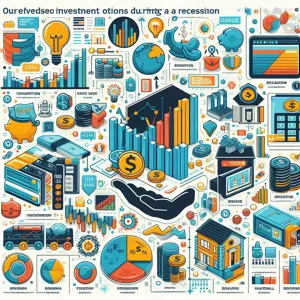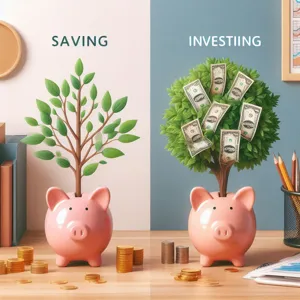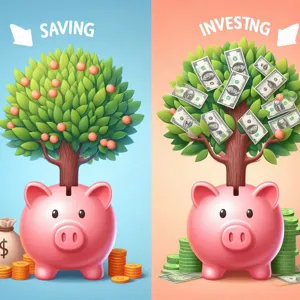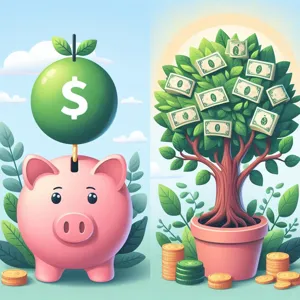When it comes to building financial security and growing wealth, one of the most important decisions you can make is determining the best time to start investing.
While it might be tempting to wait until you have more money or feel more financially stable, experts agree that the sooner you begin, the greater the benefits you’ll enjoy over time. Starting early allows your investments more time to grow through the power of compounding, giving you a significant advantage in reaching your financial goals. In this post, we’ll explore why starting to invest at a young age is crucial, the key benefits of early investing, and practical tips to help you get started no matter where you are in life. Whether you’re a recent graduate or simply considering taking the plunge, understanding why sooner is always better can set you on the path to long-term financial success.
1. Introduction: Why the Age You Start Investing Matters

When it comes to building wealth and securing your financial future, the age at which you start investing plays a crucial role. Starting early gives your money more time to grow, benefiting from the power of compounding—where the returns you earn generate their own returns over time. The longer your investments have to compound, the greater the potential for significant growth. Conversely, delaying investing means missing out on years of potential gains, making it harder to reach your financial goals. In this section, we’ll explore why starting to invest sooner rather than later can set you on the path to financial freedom and how even small contributions made early can make a big difference down the line. Whether you’re a young adult just beginning your career or someone considering investing later in life, understanding the importance of timing can help you make smarter financial decisions.
2. The Power of Compound Interest Explained
One of the most compelling reasons to start investing early is the incredible power of compound interest. Simply put, compound interest occurs when the earnings on your investments generate their own earnings over time. This means that not only are you making money on your initial investment, but also on the accumulated interest from previous periods.
Imagine planting a small seed that grows into a tree, which then produces more seeds, and those seeds grow into even more trees. The longer you allow this process to continue, the more significant your financial growth becomes. Starting to invest at a young age gives your money more time to grow exponentially, turning modest contributions into substantial wealth down the road.
For example, if you invest $1,000 at an average annual return of 7%, in 30 years, that amount could grow to nearly $8,000 thanks to compounding. But if you wait 10 years to start, your investment would only grow to about $4,000 by the same time — less than half! This clearly shows why the earlier you start, the greater your potential financial rewards. Harnessing the power of compound interest is one of the smartest ways to build a secure and prosperous future.
3. How Starting Early Maximizes Your Investment Growth

Starting your investment journey early is one of the most powerful decisions you can make to maximize your financial growth over time. Thanks to the magic of compound interest, even modest contributions made consistently can grow exponentially when given enough time. When you invest early, your money has more years to work for you, earning returns not only on your initial investment but also on the accumulated interest and gains. This “snowball effect” means that the longer your investments remain untouched, the greater the potential for wealth accumulation.
Moreover, beginning early allows you to take advantage of market fluctuations. Younger investors have the luxury of a longer timeline to ride out market volatility and downturns, which often results in higher overall returns compared to those who start later and may be forced to sell investments during unfavorable conditions. Additionally, early investing can help you develop disciplined saving habits and a deeper understanding of financial markets, setting a strong foundation for your financial future.
In essence, the sooner you start, the more time your money has to grow, and the less pressure you’ll feel to make large contributions later in life. It’s not just about how much you invest, but when you start investing that can make all the difference in achieving your long-term financial goals.
4. Common Myths About the “Right” Age to Invest
There are many misconceptions surrounding the idea of the “right” age to start investing, and these myths often discourage people from taking that crucial first step. One of the most pervasive myths is that you need to be wealthy or have a stable, high income before you can begin investing. In reality, starting with even small amounts early on can compound significantly over time, making the initial investment size less important than the act of starting itself.
Another common myth is that investing is only for older adults who are planning for retirement. This mindset can delay young people from building wealth early, missing out on decades of potential growth. The truth is that the earlier you begin, the more time your money has to grow through compound interest, which is often called the “eighth wonder of the world” for a reason.
Some also believe that investing is too complicated or risky for beginners, leading them to postpone or avoid it altogether. While investing does carry some risks, educating yourself and starting with low-risk options can ease you into the process. Most platforms today offer user-friendly tools and resources designed to help new investors make informed decisions.
Ultimately, these myths create unnecessary barriers. The best age to start investing isn’t about hitting a specific number—it’s about taking action as soon as possible. The sooner you start, the more time your investments have to grow, setting a strong foundation for your financial future.
5. Case Study: Comparing Early vs. Late Investors

To truly understand the impact of starting your investment journey early, let’s look at a practical case study comparing two individuals: Sarah and Mark.
Sarah began investing at the age of 25, consistently putting aside $200 each month into a diversified portfolio with an average annual return of 7%. Mark, on the other hand, started investing later in life, at age 40, and also contributed $200 monthly with the same average return.
By the time they both reach 65, Sarah’s early start gives her a significant advantage. Thanks to the power of compound interest, her investments have grown to approximately $370,000. Mark’s portfolio, despite the same monthly contributions and returns, totals roughly $130,000—just over a third of Sarah’s amount.
This stark difference highlights how even a 15-year head start can dramatically increase wealth accumulation. Starting early not only allows your money more time to grow but also gives you the flexibility to weather market fluctuations and adjust your strategy over time.
The takeaway? Don’t wait to begin investing. The sooner you start, the more time your money has to work for you, setting you up for greater financial security and freedom down the road.
6. The Impact of Time on Risk and Reward
When it comes to investing, time is one of your greatest allies. The longer your money remains invested, the more opportunity it has to grow through the power of compounding—where earnings generate their own earnings. Starting early allows you to take on investment risks with greater confidence because you have time to recover from market fluctuations and downturns.
For younger investors, this means you can afford to invest in higher-risk, higher-reward assets like stocks, which historically offer greater returns over the long term. As you age and approach financial goals such as retirement, you can gradually shift your portfolio toward more conservative investments to preserve capital.
Conversely, the later you start investing, the less time your money has to grow, and the more pressure you face to make up for lost time with potentially riskier moves. This often leads to a more stressful investment experience and can increase the chance of losses.
In essence, time smooths out the bumps in the road and amplifies your rewards. The sooner you begin, the more you benefit from time’s impact on risk and reward—making early investing one of the smartest financial decisions you can make.
7. How to Begin Investing in Your 20s and 30s

Starting to invest in your 20s and 30s can set the foundation for a strong financial future. The key advantage during these decades is time—time for your investments to grow and compound. Even small, consistent contributions to your investment portfolio can accumulate significantly over the years, thanks to the power of compound interest.
To begin, start by educating yourself about different types of investments such as stocks, bonds, mutual funds, and retirement accounts like IRAs or 401(k)s. Many online platforms now offer user-friendly investment options with low fees, making it easier than ever to start with modest amounts. It’s also important to establish an emergency fund before diving deep into investments, ensuring you have a financial safety net.
Consider setting clear financial goals, whether it’s saving for a down payment on a house, building retirement savings, or creating wealth for future opportunities. Automatic contributions or dollar-cost averaging—investing a fixed amount regularly regardless of market conditions—can help build discipline and reduce the impact of market volatility.
Lastly, don’t be afraid to seek advice from financial professionals or trusted resources as you begin your investment journey. Starting early not only maximizes growth potential but also helps you develop the confidence and habits needed for long-term financial success. Remember, the best time to start investing was yesterday; the second best time is today.
8. Overcoming Fear and Uncertainty When Starting Young
Starting your investment journey at a young age can feel overwhelming, especially when faced with the fear and uncertainty that often accompany financial decisions. It’s completely natural to worry about making mistakes, losing money, or not knowing enough to make the right choices. However, overcoming these fears is essential to unlocking the tremendous benefits that come with starting early.
One of the most effective ways to combat fear is through education. Taking the time to learn basic investment principles—such as diversification, risk tolerance, and the power of compound interest—can build your confidence and help you make informed decisions. Remember, investing doesn’t mean putting all your money into high-risk ventures; it’s about creating a balanced plan that aligns with your goals and comfort level.
Another important tip is to start small. You don’t need a large sum of money to begin investing. Many platforms today allow you to start with minimal amounts, letting you gain experience without feeling overwhelmed. This gradual approach reduces anxiety and helps you build momentum over time.
It’s also helpful to remind yourself that investing is a long-term journey. Market fluctuations and setbacks are normal, but by starting young, you have the advantage of time to recover and grow your wealth steadily. Instead of fearing short-term volatility, focus on your long-term goals and the growth potential that patience can bring.
Ultimately, overcoming fear and uncertainty is about taking that first step, no matter how small, and continuously learning along the way. The sooner you start, the more time your money has to work for you—and that’s a powerful advantage you don’t want to miss.
9. Strategies for Different Life Stages
Investing isn’t a one-size-fits-all journey; your strategy should evolve as you move through different life stages. Understanding how to tailor your investments based on your age, financial goals, and risk tolerance can make a significant difference in building wealth over time.
**In Your 20s and 30s:** This is the time to be bold. With decades ahead, you can afford to take on more risk by investing heavily in growth-oriented assets like stocks or equity funds. The power of compounding works best when you start early, so prioritize consistent contributions even if they’re small. Focus on building a diversified portfolio, and don’t be afraid to learn and adjust your approach as you go.
**In Your 40s and 50s:** As retirement nears, it’s wise to start balancing risk and security. Gradually shift some investments toward more stable assets such as bonds or dividend-paying stocks to preserve capital while still seeking growth. This stage is also crucial for maximizing contributions to retirement accounts and catching up on any missed savings.
**In Your 60s and Beyond:** Preservation becomes paramount. Focus on protecting your nest egg and generating steady income through conservative investments like bonds, annuities, or income-focused funds. It’s important to carefully plan withdrawals to ensure your savings last throughout retirement, while still allowing for some growth to keep pace with inflation.
By adapting your investment strategy to fit your life stage, you can optimize growth, reduce unnecessary risks, and set yourself up for financial security. Remember, the key is to start early and be intentional about evolving your approach as your needs change.
10. The Role of Financial Education in Early Investing
Financial education plays a crucial role in setting the foundation for successful early investing. Understanding the basics of how investments work, the different types of assets available, and the risks involved empowers individuals to make informed decisions rather than relying on guesswork or hearsay. When you start investing at a young age, having a solid grasp of financial concepts—such as compound interest, diversification, and risk tolerance—can dramatically improve your ability to grow wealth over time.
Moreover, financial education helps you develop a disciplined approach to saving and investing, enabling you to set realistic goals and stick to them even during market fluctuations. It also equips you with the knowledge to recognize and avoid common pitfalls, such as high-fee funds or impulsive trading. By prioritizing financial literacy early on, you build confidence and reduce anxiety around money management, making investing a natural and sustainable habit. In essence, the sooner you educate yourself about finances, the sooner you can harness the power of investing to secure your financial future.
11. Tips for Building Good Investment Habits Early On
Developing strong investment habits early in life can set the foundation for long-term financial success. The key is consistency and discipline—two qualities that, when cultivated from the start, can significantly enhance your wealth-building journey. Begin by setting clear financial goals and creating a realistic budget that allows you to allocate a portion of your income toward investing regularly, even if the amounts are small. Automating your investments through monthly contributions to retirement accounts or brokerage accounts helps maintain discipline and removes the temptation to skip contributions. Additionally, take time to educate yourself about different investment options and risk management strategies; knowledge empowers you to make informed decisions and avoid common pitfalls. Remember, patience is crucial—resist the urge to chase quick gains, and instead focus on steady, long-term growth. By building these habits early on, you’ll be well on your way to harnessing the powerful benefits of compounding and securing your financial future.
12. The Cost of Waiting: Missed Opportunities and Lost Gains
One of the most significant reasons why starting to invest early is crucial lies in understanding the true cost of waiting. Every year you delay investing is a year of missed opportunities—opportunities for your money to grow, compound, and work hard on your behalf. The power of compound interest means that the returns you earn not only generate more returns but the longer your investments have to grow, the more exponential this growth becomes.
Consider this: if you begin investing at age 25, your money has decades to multiply, weather market fluctuations, and capitalize on long-term growth trends. On the other hand, waiting until age 35 or 45 significantly reduces the time your investments have to compound. Even a few years’ delay can result in tens of thousands—or even hundreds of thousands—of dollars left on the table by the time you retire.
Moreover, starting early allows you to take more risks while you’re young, potentially increasing your returns, and gives you ample time to recover from any market downturns. Waiting not only diminishes your potential gains but also forces you to invest larger sums later in life to catch up, which might not be feasible for everyone.
In essence, the cost of waiting isn’t just about the dollars you don’t invest today; it’s about sacrificing the powerful momentum your investments could have built over time. When it comes to investing, sooner truly is always better.
13. How to Balance Investing with Other Financial Goals
Balancing investing with other financial goals is essential to building a strong and sustainable financial future. While investing early can significantly boost your wealth over time thanks to compound interest, it’s equally important to ensure that you’re not neglecting other critical financial priorities. Start by clearly defining your short-term and long-term goals—whether that’s paying off high-interest debt, building an emergency fund, saving for a home, or funding education. Allocating your money wisely means striking a balance between these objectives and your investment contributions.
A practical approach is to establish a solid financial foundation first. This usually means paying down high-interest debts and setting aside three to six months’ worth of living expenses in an emergency fund. Once these are in place, you can confidently channel more funds toward investments without jeopardizing your financial security. Remember, investing doesn’t have to be all or nothing; even small, consistent contributions can grow substantially over time.
Moreover, regularly revisiting and adjusting your budget is key as your priorities and circumstances evolve. For example, if you’re saving for a major purchase or planning for a family, you might temporarily reduce your investment contributions to meet those goals. On the other hand, once those goals are met, you can increase your investments to accelerate your wealth-building journey.
Ultimately, balancing investing with other financial goals requires thoughtful planning and flexibility. By prioritizing your immediate needs while steadily investing for the future, you set yourself up for both financial stability and long-term growth.
14. Tools and Resources for Young Investors
Starting your investment journey at a young age is a powerful step toward building long-term wealth, and fortunately, today’s digital landscape offers an abundance of tools and resources designed specifically to help young investors succeed. From user-friendly investment apps to educational platforms, these resources make it easier than ever to learn the ropes, manage your portfolio, and make informed decisions.
One popular category is robo-advisors, such as Betterment and Wealthfront, which use algorithms to create and manage diversified portfolios tailored to your risk tolerance and goals—all with minimal fees and hands-on effort. These platforms are perfect for beginners who want to get started without the complexity of traditional investing.
For those who prefer a more hands-on approach, apps like Robinhood and E*TRADE offer commission-free trading and intuitive interfaces that simplify buying and selling stocks, ETFs, and other assets. Many of these apps also provide educational content, real-time market data, and community forums where you can connect with fellow young investors.
Beyond apps, there’s a wealth of online courses, podcasts, and blogs dedicated to personal finance and investing. Websites like Investopedia and Khan Academy offer free tutorials that break down complex concepts into digestible lessons. Podcasts like “The Dave Ramsey Show” or “BiggerPockets Money Podcast” provide practical advice and inspiring stories from experienced investors.
Lastly, don’t overlook the power of financial literacy books tailored for young adults, such as *The Simple Path to Wealth* by JL Collins or *Rich Dad Poor Dad* by Robert Kiyosaki. These resources not only teach you about investing but also help cultivate a mindset geared toward financial independence.
By leveraging these tools and resources early on, young investors can build confidence, avoid common pitfalls, and maximize the growth potential of their investments. Remember, the sooner you start, the more time your money has to grow—and these resources are here to guide you every step of the way.
15. Conclusion: Taking Action Today for a Secure Financial Future
Waiting for the “perfect” moment to start investing often means missed opportunities. The reality is, the best time to start investing is now—regardless of your age or financial situation. By taking action today, you harness the power of compounding, giving your money more time to grow and work for you. Even small, consistent contributions can accumulate into a significant nest egg over the years. Remember, investing is not about timing the market but time in the market. The sooner you start, the greater the potential to build wealth, achieve your financial goals, and secure a comfortable future. Don’t let hesitation hold you back—begin your investment journey today and take control of your financial destiny. Your future self will thank you.
In conclusion, starting to invest as early as possible is one of the smartest financial decisions you can make. The power of compounding, time in the market, and the opportunity to learn and adapt along the way all contribute to building a stronger, more secure financial future. Whether you’re in your twenties or just beginning to think about investing, remember that the best age to start is always now. By taking that first step sooner rather than later, you set yourself on a path toward achieving your financial goals and enjoying greater peace of mind in the years to come. Don’t wait—embrace the opportunities of today and watch your investments grow over time.




































